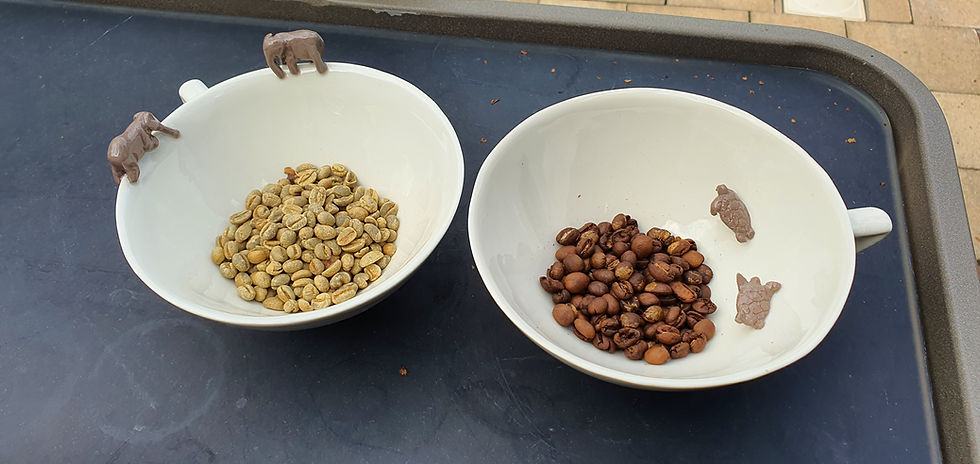I Roasted My Own Coffee At Home
- Andras Liptak
- Jun 3, 2023
- 4 min read
Updated: Jun 5, 2023
Experiment And Find The Best Tastes For Yourself

My girlfriend surprised me with a package of Brazilian specialty coffee, made of perfect, regular Arabica coffee beans. However, it would have been very difficult - if not impossible - for me to make my usual espresso from these raw, green, unroasted beans, so we had no choice but to roast it. It's not the first time we've done this, I love to roast my own coffee beans to find out how to get the best taste out of it. Needless to say: „best” is a term that means something else for everyone.
Now we chose a relaxing day in the weekend. The weather was nice, the sun was shining beautifully, so the garden stove was a perfect choice. Roasting coffee produces strong aromas, which is mesmerizing for any coffee lover, yet, it requires thorough ventilation in the apartment during and after the process, if done inside.
I also got my traditional coffee roaster from my girlfriend earlier, which is a special ceramic pot. It is very easy to use. We pour a handful of green coffee beans into it from the top, then roast them on a small fire, with continuous circular movements, until we reach the combination of color and aroma that pleases all our senses.
We now roasted the coffee beans to medium dark, which took about 15 minutes. This is a safe approach when working with new coffee, as over-roasting might result in the loss of some specific flavor, and it is not at all certain that the type is suitable for a dark-roasted coffee experience. At the same time, it is also not certain that a good result can be achieved with a very light roasting that is so popular nowadays, because the specific flavors are not always to our taste. In addition, many home coffee machines are not really suitable for properly brewing light roasted coffee, so it can even cause disappointment. The reason I roast it to medium strength is because most high-quality Arabica coffees can almost certainly release a delicious flavor this way, and after tasting it I can tell how to do it next time.
After the process, I let the finished roasted coffee cool a few minutes in a cup, and then sealed it in a bottle for a day to let it "rest" a little and mature its flavors.
In the end, there was nothing left but the tasting. This happened the next afternoon, it was already my second espresso that day. Both I and my girlfriend were satisfied with the result. Next time, we will try to roast it for two or three minutes longer, but until then we can enjoy it this way at least twice more.
How could it be any better? Hand roasted coffee from our favorite handmade mugs.
As easy as it sounds, a few things are definitely worth paying attention to:
The pot heats up very quickly and, thanks to its special shape, traps the heat very effectively. On the one hand, this enables efficient coffee roasting, but on the other hand, it requires continuous circular movement, otherwise one side of the coffee beans will burn in seconds.
Although there is a leather coating on the handle, it gets hot easily if the flame is too high that makes it painful to hold and move it properly. It is therefore not worth rushing the process by increasing the fire.
During roasting, the outer shell of the coffee beans cracks off and needs to be removed before blending because it gives the brew a bad taste. However, the design of the coffee roaster makes it easier to get rid of them. We simply have to blow through the hole at the end of the handle a couple of times so that the pieces of the shell can escape towards the hole on top of the pot. They are very light and immediately come out of the pot with the blow. It might be worth repeating this a few times, especially if you are roasting a large amount of coffee at once.
The shape of the pot has been specifically designed to retain the heat as much as possible, so it is not necessary and not even worthwhile to constantly move it over the fire to avoid burning the coffee beans. You can move it for half a minute or so away from the heat, so the coffee beans continue to roast in it, and when the pot has cooled a little - do not touch it, it is still burning hot for your hands – then it is enough to continue moving it over the fire again for a few seconds.
When we have reached the desired level of roasting, preferably sprinkle the freshly roasted coffee beans into a separate container, because – as I have already mentioned – the roaster is still very hot and will burn them if left inside.
I love watching the coffee beans during the process. They first change to a yellowish color, then turn to brown, which gets darker and darker. It is not defined what the end result should be, it is all about experimentation. If we need reference, we can choose a coffee that has not yet been blended and that we have already tried, so we can compare its color to ours and stop roasting when necessary.
